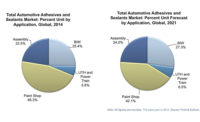Market Trends: Automotive Industry Keeps Thermoplastic Elastomers Market Strong
About 40% of all TPE products consumed worldwide are used in the manufacturing of vehicles.

In the course of several product innovations, thermoplastic elastomers (TPEs) are increasingly replacing standard plastics and conventional elastomers. Due to far-reaching options for the combination of elastic and thermoplastic phases, TPEs are among the most dynamically developing materials. They are mainly used in the automotive industry, but new applications are continuously being found in other sectors. Revenues generated with TPE amounted to $16.7 billion in 2014; market research company Ceresana forecasts annual revenues generated with TPE to increase by 4.7% per year until 2022.
Regions
Demand for TPE is strongly focused on the largest economic powers: the U.S., China, Japan and Germany are the four largest consumers, which together accounted for about 63% of global TPE demand in 2014. The highest growth rates are projected for South America and Asia-Pacific, especially China, India, and Brazil. However, consumption in North America and Western Europe is expected to increase by at least 2% per year in the future as well.
The TPE market’s continuous growth in recent years, particularly in Asia, saw several new producers entering the market. China alone increased its TPE production by more than 600,000 tons in the past eight years, and was able to slightly reduce its net imports, despite strongly increasing demand.
Applications
Given their versatility and easy processing, TPEs are predominantly used in the automotive industry. About 40% of all TPE products consumed worldwide are used in vehicle manufacturing. Therefore, the development of the automotive and transport industries, as well as their suppliers, is an important indicator for forecasts of future TPE demand. As there are numerous types of TPE, each with highly diverse properties, TPE applications in the automotive industry are widespread and cover segments ranging from fabric coating to sealing components and bumpers.
The construction industry and other industrial branches, such as machine construction or medical technology, are also using increasing amounts of TPE. Demand for TPE in these sectors will rise by more than 4% per year. Other important application areas are shoes (especially soles) and sporting goods, as well as consumer goods such as toys and household items.
TPE Types
The market shares of individual types of TPE vary widely among individual countries, mainly due to the different sizes of respective sales branches and the variation of quality standards and price levels. The most commonly used type of TPE on the global market by far is styrene block copolymers (SBCs). Their applications reach from adhesive admixtures to asphalt modification in road construction. Asian countries—China and India in particular—report a very large share of the SBC market.
The second-largest TPE market comprises thermoplastic polyolefins (TPOs), which are mainly used in the automotive industry. Thermoplastic polyurethanes (TPUs) are another important class of TPE. The highest growth rates are predicted for thermoplastic vulcanizates (TPVs), which are used in applications such as hoses and seals.
For more information, call (49) 7531-942930, email info@ceresana.com or visit www.ceresana.com/en.
Looking for a reprint of this article?
From high-res PDFs to custom plaques, order your copy today!





